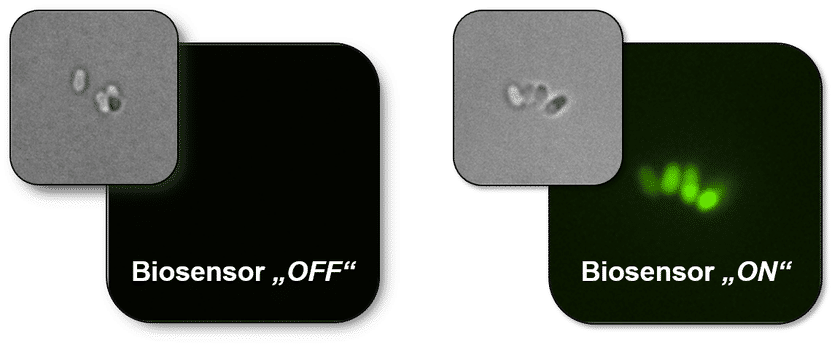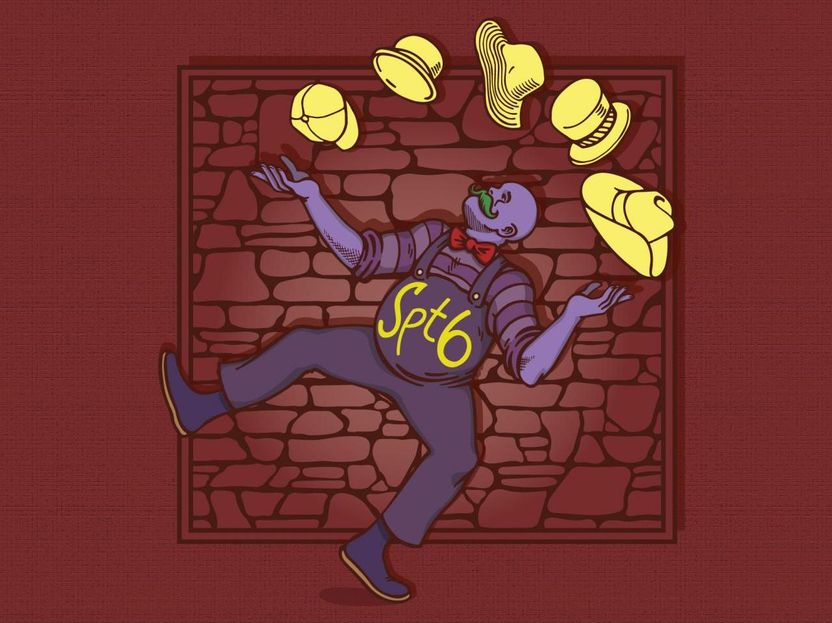Talent Scout in the Cell Factory
New biosensor facilitates the search for efficient microorganisms
They’re small, but mighty: microorganisms. The industry known as “white biotechnology” takes advantage of their potential in a variety of ways, for example to produce chemicals, medicines, or dietary supplements. The little powerhouses’ work can be found in a whole series of products, the number of which is set to increase in future. For example, the bacterium named Corynebacterium glutamicum produces several tonnes of the amino acids isoleucine, valine, and threonine. Humans cannot produce these amino acids themselves. They are needed for infusion solutions in hospitals, among other applications.

Let there be light: The larger picture is a fluorence microscope image. The picture on the right shows very clearly how the biosensor makes the relevant cells glow.
Copyright: Forschungszentrum Jülich / Jan Marienhagen
The diversity of microbially synthesized substances reflects the broad spectrum of fields of application. The possible uses range from enzymes in detergents to producing medicines and biofuels. Along with this wide range, the sustainability of the fundamental production method is another crucial advantage of this resource. Unlike many chemical processes, which consume large amounts of energy, in this case, simple, regenerative components form the basis for biologically based production processes. A crucial role is therefore ascribed to white biotechnology in the transition from an economy resting on fossil fuels to a bio-based one, since as small as these producers are, the expectations of these “mini-factories” are great.
A needle in a haystack
One major hurdle standing in the way of biotechnological production of new or even established substances on an industrial scale is often the arduous job of determining bacterial cells that are particularly well suited to the procedure. Identifying cell variants that can produce the molecules of interest particularly well is equivalent to looking for a needle in a haystack – if not even harder. That’s because the bacterial cultures to be examined can consist of many billions of cell variants. Ultimately, the larger the number of variants that the scientists generate, the better the prospect is of finding the right candidate. By comparison, the chance of winning the lottery is around 1:95 million, depending on the draw. Considering this order of magnitude in the difference, it quickly becomes clear that the process of looking for microbial talents is usually very time-intensive and thus expensive.
Lights are on in the cell factory
That is why the “Synthetic Cell Factories” research unit headed by the Jülich scientist Prof. Jan Marienhagen is relying on a new method to uncover the most promising candidates more quickly. It uses specialized biosensors to identify individual cells that can produce a relevant molecule particularly well. If the substance in demand is present, the sensor causes the cells in question to light up. It “switches the light on” in this way so that the best cells can be easily found among all the millions of others. “If this technology is combined with a cell sorter, tens of thousands of cells can be assessed for their fluorescence intensity (and thus the molecule concentration) every second, and so highly productive individual cells can be identified,” explains Prof. Marienhagen.
So far, this innovative approach, which is many times faster than traditional methods of analysis, has only one problem: Its results are not as accurate yet as could be hoped. Put simply, the sensor switches the light on not just when the candidate in demand is in the room, but when one of its close friends is around as well. “Many sensors that are built are not very specific and detect multiple substances that are very similar to each other. This leads to many apparently great producers then turning out to be false positives,” Prof. Marienhagen says of the method’s pitfalls.
Customized sensor
In an article published in the journal Nature Communications, the researcher from Jülich, together with other scientists, describes a procedure for improving the significance of the existing method. “We have successfully modified the specificity of a biosensor that previously detected both the amino acid histidine and the amino acid lysine. Following our modification, it could no longer identify lysine.” The subject of study here was the bacterium Corynebacterium glutamicum mentioned above. Precise manipulation of the biosensor eliminated its original blur. To extend the metaphor in the title of this article further, if the talent scout could already tell the difference between a footballer and a handball player, now they can even pick out the striker up front. Prof. Marienhagen and his team have thus shown that it is possible to develop customized sensors, which is an important step on the path to efficient cell factories for a sustainable, bio-based economy.
Original publication
Other news from the department science
These products might interest you
Most read news
More news from our other portals
See the theme worlds for related content
Topic World Cell Analysis
Cell analyse advanced method allows us to explore and understand cells in their many facets. From single cell analysis to flow cytometry and imaging technology, cell analysis provides us with valuable insights into the structure, function and interaction of cells. Whether in medicine, biological research or pharmacology, cell analysis is revolutionizing our understanding of disease, development and treatment options.

Topic World Cell Analysis
Cell analyse advanced method allows us to explore and understand cells in their many facets. From single cell analysis to flow cytometry and imaging technology, cell analysis provides us with valuable insights into the structure, function and interaction of cells. Whether in medicine, biological research or pharmacology, cell analysis is revolutionizing our understanding of disease, development and treatment options.


























































